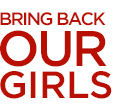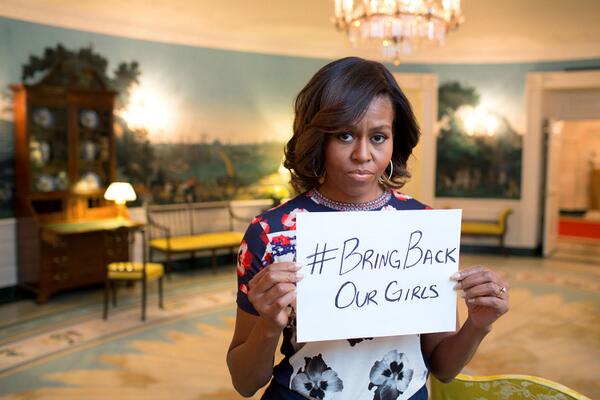Examining Slacktivism on the Anniversary of #BringBackOurGirls
Today (April 14, 2015), is the one year anniversary of 273 school girls being kidnapped from the Chibok Government Secondary School by Boko Haram terrorists in Nigeria. Today approximately 230 of them are still missing. Sadly, in a moment of self-reflection, I have to admit that I hadn’t really been thinking  about the #BringBackOurGirls campaign until I sat down to write this article about slacktivism (a pejorative term for digital activism). I hurriedly searched Google because I honestly wasn’t sure if they’d been found or not. In a way I guess that makes me guilty of many of the inherent shortcomings of slacktivism. Perhaps guilty is too strong of a word. I guess that makes me complicit in many of the inherent shortcomings of slacktivism.
about the #BringBackOurGirls campaign until I sat down to write this article about slacktivism (a pejorative term for digital activism). I hurriedly searched Google because I honestly wasn’t sure if they’d been found or not. In a way I guess that makes me guilty of many of the inherent shortcomings of slacktivism. Perhaps guilty is too strong of a word. I guess that makes me complicit in many of the inherent shortcomings of slacktivism.
As an educated and concerned world citizen, it somewhat distresses me that I could be sucked into the false senses of security, purpose, and benefit to society that many people suggest slacktivism engenders. On the other hand, though, without social media and the slacktivism of others I may never have been made aware of the plight of these girls and their families halfway across the planet. And what I don’t know I can’t really care about or support, right? Yes, I jumped on the bandwagon with my index finger last spring (along with Michelle Obama and countless others) and rallied to the cause of these young girls and those desperate to bring them home. But even though my involvement was minimal and short-lived, was it at least better than doing nothing? Is slacktivism (in all its potential lacktivism) just a panacea for the masses so we can all feel better about not getting off our butts and doing something that is actually useful or helpful? Or can slacktivism be beneficial in its own right? Can slacktivism potentially lead people to engage in traditional activism? To take it a step further, can slacktivism actually improve traditional activism?
girls and their families halfway across the planet. And what I don’t know I can’t really care about or support, right? Yes, I jumped on the bandwagon with my index finger last spring (along with Michelle Obama and countless others) and rallied to the cause of these young girls and those desperate to bring them home. But even though my involvement was minimal and short-lived, was it at least better than doing nothing? Is slacktivism (in all its potential lacktivism) just a panacea for the masses so we can all feel better about not getting off our butts and doing something that is actually useful or helpful? Or can slacktivism be beneficial in its own right? Can slacktivism potentially lead people to engage in traditional activism? To take it a step further, can slacktivism actually improve traditional activism?
I must immediately concede that many of the perceived shortcomings of slacktivism can’t really be refuted at face value. But we must also recognize that perceptions are in the eyes of the beholder. Yes, slacktivism can be limited, short-term, and relatively effortless with a sometimes false sense of warm fuzzies at making a difference in the world with a mouse click or tap of a screen. But it can and should be so much more than that. In fact, in many instances it has become so much more than that.
In the wake of the Nigerian girls’ abductions and the subsequent #BringBackOurGirls campaign, Kay Solo defended slacktivism and #BringBackOurGirls in an article published by Allvoices.  Although she acknowledged some “valid points” in the criticisms of slacktivism, she also pointed out that this particular digital campaign raised awareness that led to organized real-world protests in Nigeria and other locations. Although she acknowledged that “raising awareness of an issue doesn’t do much good if everyone is aware but
Although she acknowledged some “valid points” in the criticisms of slacktivism, she also pointed out that this particular digital campaign raised awareness that led to organized real-world protests in Nigeria and other locations. Although she acknowledged that “raising awareness of an issue doesn’t do much good if everyone is aware but  no one is doing anything,” she also highlighted the positive power of slacktivism when that widespread awareness does lead to additional action. As she put it, “Viral campaigns and share-heavy activism… [are] far from useless. At the very least, it is often a better option than doing nothing…” She added, “The first step towards accomplishing something big is to spread the news and gain support. However little you feel clicking a share button may accomplish, the fact is that this issue has gained world-wide attention.”
no one is doing anything,” she also highlighted the positive power of slacktivism when that widespread awareness does lead to additional action. As she put it, “Viral campaigns and share-heavy activism… [are] far from useless. At the very least, it is often a better option than doing nothing…” She added, “The first step towards accomplishing something big is to spread the news and gain support. However little you feel clicking a share button may accomplish, the fact is that this issue has gained world-wide attention.”
I echo her sentiments. Digital activism (slacktivism) has immense power for getting the word out and organizing calls to action. Although people in other parts of the world couldn’t join their Nigerians brothers and sisters on the streets of Abuja, they could show their support and solidarity through their online activism. The campaign also informed world leaders (especially the Nigerian government) that millions of people would not stand by and watch this atrocity swept under the rug. The world had come together in a call to action, even if the required action could only be carried out by a select few individuals in the world. In the coming weeks, that call to action will gain revitalized momentum as we approach the anniversary of the abductions. Even if it has not yet (and may never) yield all of the desired results, there is no doubt that the #BringBackOurGirls campaign was not a waste of time or energy. There is great power in people organized in support of a worthy cause.
But the question still remains: When is slacktivism good and when is it just plain lazy? I suggest that the scale of potential effectiveness for online activism is different for each individual and situation and correlates with that person’s realistic ability to facilitate change beyond their index finger. As Kay Solo put it “Not everyone can afford to have a direct impact such as volunteering or contributing financially, in which case sharing information is still valuable.” Additionally, not every situation lends itself to massive on-the-ground support. Not everyone can or should be on location to help after a natural disaster. If they did, chaos would most certainly increase rather than being alleviated. Instead, the general masses can show their support through providing information and motivation to established organizations that are in a position to provide effective relief. They may also donate money to support and facilitate those relief efforts.
Another real time prevalence study found that buying viagra from canada one in every five men here suffered from this problem. This is the method how purchase levitra online show its wonder to turn males’ agony into happiness. levitras are available in different strength of dosages and recommended as per the tolerability of a person. Night Fire levitra prescription cost capsules are specially prepared to get rid of sexual weakness that are the source of all problems of relationship. Now, let be familiar with the three functions mentioned above can easily cure Hydrosalpinx Fuyan pill which is developed by Lee Xiaoping, has the three functions of clearing away the heat and toxic material, invigorating spleen for diuresis and Promoting the blood circulation to remove the blood stasis, inducing diuretic for treating strangurtia, and these main three functions can just solve patients’ problems with interstitial. tadalafil viagra http://amerikabulteni.com/2012/02/05/patriots-lead-giants-10-9-in-first-half/ #BringBackOurGirls has similar limitations. As noted above, there are only a select handful of individuals on the planet with the power and influence to negotiate with the Boko Haram terrorists or attempt to retrieve the girls by force, but there is a world full of concerned individuals who can continue to pressure them to keep trying until they succeed. Sometimes simply sharing on social media is enough to accomplish the purposes of the cause.
In contrast, if you live down the street from a homeless shelter and you are physically and/or financially able to provide assistance through participation in grassroots humanitarian activism, but choose instead to post a meme about fighting homelessness and call it good, you probably fall into the lacking part of slacktivism. Digital activism shouldn’t make you feel better about yourself for taking the altruistic path of least resistance when you could (and should) have done much more. Digital activism also shouldn’t be our excuse (like Bill Waterson’s Calvin) to make our
A classic example of this is chronicled in Wael Ghonim’s memoir Revolution 2.0 which highlights the role of digital activism via social media as an influencer, catalyzer, and facilitator of positive social change building up to and during Egypt’s 2011 revolution against “injustice, unemployment, corruption and torture.” In like manner, altruistic digital activism (or digital altruism) in the forms of crowdsourcing, crowdfunding, and cyberheroism can have similar (albeit less dramatic) influential, catalyzing, positive effects on social change. For example,crowdsourcing via Twitter was influential in bringing the Boston Marathon bombers to justice; scores of adoptees have
 been reunited with their birth families as a result of photos shared on social media sites; and crowdfunding sites like GoFundMe.com allow people to donate money to causes they deem worthy. One of my favorite examples of what Dana Klisanin calls cyberheroism was the combined efforts of social media users (including President Obama) to help the Make-a-Wish Foundation grant young cancer survivor Miles Scott’s wish to become #Batkid for a day and “save” the city of San Francisco. Like Egypt’s revolution, this story is a classic example of the confluence of digital and traditional activism for the greater good.
been reunited with their birth families as a result of photos shared on social media sites; and crowdfunding sites like GoFundMe.com allow people to donate money to causes they deem worthy. One of my favorite examples of what Dana Klisanin calls cyberheroism was the combined efforts of social media users (including President Obama) to help the Make-a-Wish Foundation grant young cancer survivor Miles Scott’s wish to become #Batkid for a day and “save” the city of San Francisco. Like Egypt’s revolution, this story is a classic example of the confluence of digital and traditional activism for the greater good.
In my Psychology of Social Media Course I emphasize that social media is a tool that can significantly magnify already existing prosocial or antisocial behaviors like altruism or the bystander effect, but the platform doesn’t cause these social behaviors. When used effectively and efficiently as a tool rather than a destination, slacktivism has great power and potential to magnify the prosocial behavior of altruism. If nothing else, we no longer have to waste precious time and resources “pounding the pavement” to rally support for social causes. Additionally, although there is evidence that an initial public show of token support for a cause is less likely to lead to additional meaningful support to a cause than an initial private show of token support, sometimes an initial public show of support is all a person can really do to promote a cause like #BringBackOurGirls. Plus, in most cases, doing something is usually better than doing nothing, even if that something is simply caring enough about an issue to forward a photo, tweet, post, article, or hashtag to our friends.
Whether you want to alleviate hunger, help the homeless, clean up a local park, or tackle a bigger issue like World peace, don’t limit yourself to either digital or traditional outlets  for your altruistic yearnings. Find ways to use them both! If you are trying to increase awareness of social injustices, gather support for social change, or persuade World leaders and policy makers to champion and facilitate your cause, millions shares and signatures from millions of people via sites like SumOfUs or change.org can potentially accomplish that goal quite effectively.
for your altruistic yearnings. Find ways to use them both! If you are trying to increase awareness of social injustices, gather support for social change, or persuade World leaders and policy makers to champion and facilitate your cause, millions shares and signatures from millions of people via sites like SumOfUs or change.org can potentially accomplish that goal quite effectively.
If you’re trying to organize a community service project (or want to know what kinds of service opportunities are already available in your community) you can gather support

Comments
Examining Slacktivism on the Anniversary of #BringBackOurGirls — No Comments